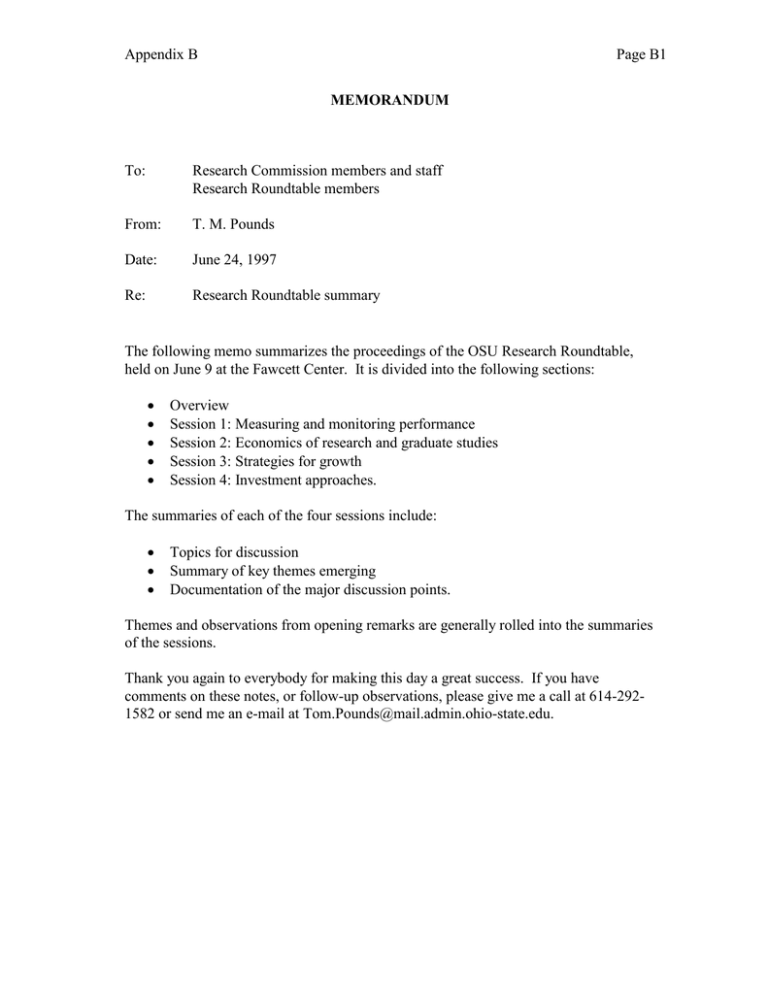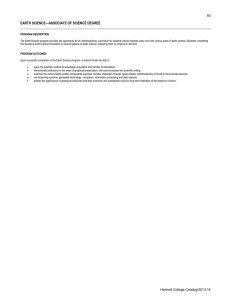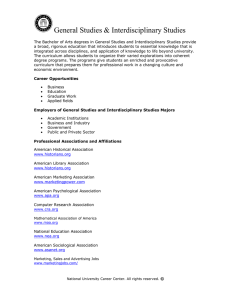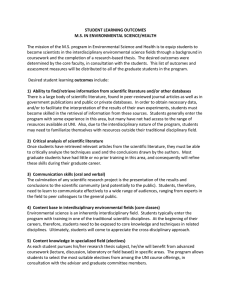Final Report Appendix B
advertisement

Appendix B Page B1 MEMORANDUM To: Research Commission members and staff Research Roundtable members From: T. M. Pounds Date: June 24, 1997 Re: Research Roundtable summary The following memo summarizes the proceedings of the OSU Research Roundtable, held on June 9 at the Fawcett Center. It is divided into the following sections: Overview Session 1: Measuring and monitoring performance Session 2: Economics of research and graduate studies Session 3: Strategies for growth Session 4: Investment approaches. The summaries of each of the four sessions include: Topics for discussion Summary of key themes emerging Documentation of the major discussion points. Themes and observations from opening remarks are generally rolled into the summaries of the sessions. Thank you again to everybody for making this day a great success. If you have comments on these notes, or follow-up observations, please give me a call at 614-2921582 or send me an e-mail at Tom.Pounds@mail.admin.ohio-state.edu. Appendix B: OSU Research Roundtable Discussion Notes Page B2 OVERVIEW Roundtable members: Michael Cusanovich W. R. “Reg” Gomes Steven Mailloux Richard Alkire Maynard Thompson Farris Womack Stuart Bondurant Bernadine Healy Edward Hayes Richard Sisson Donald Mattison David Shirley George Bernier John Wiley John D’Arms VP Research/Graduate Dean VP, Division of Agr. and Nat’l Res. Associate Dean, Graduate Studies VP, Research Vice Chancellor & Dean VP, Finance, Retired Interim Dean, School of Medicine Dean, College of Medicine VP, Research Provost Dean, Grad School of Public Health Previous VP Research Dean, School of Medicine Provost Incoming President Univ. of Arizona Univ. of California Cal Irvine Illinois Urbana Indiana Univ. Univ. of Michigan UNC - Chapel Hill Ohio State Univ. Ohio State Univ. Ohio State Univ. Univ. of Pittsburgh Penn State/Cal Berkeley Univ. of Texas - Galveston Univ. of Wisconsin American Council of Learned Societies Chair, Bernadine Healy Moderator, Janet White Invited audience: Research Commission Members, Staff, and Adjunct Members University Research Committee College Deans and Research Officers Chairs, Budget Restructuring Teams Chairs, Senate Steering Committee and Faculty Council Provost and Vice Provosts President and President’s Executive Committee The four sessions, and presenters: 1. 2. 3. 4. Measuring and monitoring performance Economics of research and graduate studies Strategies for growth Investment approaches Robert Perry Randy Olsen Bob Brueggemeier Bud Baeslack Appendix B: OSU Research Roundtable Discussion Notes Page B3 Session 1: MEASURING AND MONITORING PERFORMANCE Topics for discussion: 1. Are federal funding and NRC quality ratings the right metrics for academic unit performance? Does your institution track performance against these or other explicit metrics? What is the relationship between external research funding and institutional rankings/quality? How does one influence the other? 2. How do you benchmark the performance of academic support activities, e.g. library resources? 3. How is the benchmarking data used at your institution? E.g., for performance assessment, resource allocation, goal setting 4. Who is responsible for data collection and analysis? Key themes: Use benchmarking data to frame questions, not reach conclusions Federal funding and NRC rankings are reasonable metrics, if sensibly applied Increased federal funding is a product of a high-performing faculty, not vice-versa Benchmark at the discipline level, and choose specific metrics and programs/ universities for comparison accordingly Discussion points: 1. Benchmark for insight, not guidance: some prefer the term “evaluation” to “benchmarking”. 2. General agreement that federal funding and NRC quality rankings are useful and informative metrics, with the caveats noted below: Federal funding requires the most intensive peer review, and is thus the best indicator of quality NRC quality rankings are the best of their type available: “the simplest way of providing actual numbers” Both are simple to access and analyze 3. Caveats: “Though these are both reasonable metrics they are not necessarily the best” Funding is an indicator of performance, not a goal in itself (Wiley) Federal funding is only relevant to some disciplines, and should not be applied uniformly (Mailloux) Tracking other sources of funding may be important, if the university has an interest in a diversified portfolio (Wiley) Need to normalize funding data: $ per FTE by discipline Need to distinguish quality of federal research; be alert to “bottom-feeding”, even in federal funding (Shirley) NRC data needs to be treated with care: Appendix B: OSU Research Roundtable Discussion Notes Page B4 Rank-error bias makes rankings much less precise than they appear, especially in the middle quartiles of rankings (Wiley proposes approach to account for this in his blue-book) Limited to faculty input only – ideally should have included graduate student and/or employer ratings of programs for broader view (from D’Arms, who played a role in shaping the ’93 survey) 4. Several described major efforts to establish metrics: Illinois: developing 20-30 performance metrics, by unit Self-developed by departments, shared with deans emphasis on simple, accessible data - easy to compile run by Graduate College – for arbitration, as needed Structured as a “health care” issue - systematic annual reviews, with indepth exams every 10 years U. Cal system: in the process of setting system-wide metrics & performance goals Penn State, Arizona: academic units set goals and then are measured against them – “they pick their own poison.” 5. On selecting benchmark institutions: For measuring performance of academic units, focus on identifying key peers appropriate to specific disciplines Why these 20 peer institutions? What vision for Ohio State could put Virginia and Georgia Tech. on the same list? Wisconsin’s benchmarks: selected CIC schools, plus Cal Berkeley, Texas – Austin, and Washington (10-12 total) “Why no privates? OSU is privately supported, and privates get big public support, in the form of government contracts. Adding some will add perspective, while not having any will create a distinction that really isn’t there anymore” (D’Arms) A contrary view from Indiana: experience suggests that for improving academic unit performance, longitudinal analysis within units works as well as or better than external comparisons, and tends to be less threatening/ contentious. 6. Alternative metrics proposed/in use: Outcome measures: student placement, employer satisfaction (Some professional associations beginning to play a role in data collection here) Ability to attract top people: rate of success in recruiting faculty and students “Market share” of best faculty, graduate students Ability to retain good people: early departures of faculty in prime of career (at 45-50) a very serious negative indicator # of high quality fellowships, # of faculty members in leading professional associations & societies Faculty and student satisfaction Production of graduate students Effectiveness and alignment of research programs with state and federal objectives Appendix B: OSU Research Roundtable Discussion Notes Page B5 Outcome benchmarking - link to technology transfer Quality of relationships with funding agencies, sponsors, actors, e.g., number of people on directors advisory committee at NIH span of interactions at state, federal governments, e.g., State Inst. Of Medicine Quality of infrastructure - libraries, museums/collections Are we “serving the needs of the people of the state”? Other interesting observations to follow up: Change in NRC rankings from ’82 to ‘93 suggests low mobility in top quartile in hard sciences, but potential for large moves in humanities There was little or no discussion of the questions relating to academic support activities (e.g., library) or responsibility for data analysis and collection. Appendix B: OSU Research Roundtable Discussion Notes Page B6 Session 2: THE ECONOMICS OF RESEARCH AND GRADUATE STUDIES Topics for discussion: 1. What are the best budget incentives for encouraging quality research and graduate programs? How do you reward academic units for bringing funded research to campus? 2. Does more sharing of IDC-recovery encourage grantsmanship? 3. What are the best practices for allocating the facilities and administrative (“F&A”) costs that are recovered from sponsored projects? 4. How do you manage the mix of projects paying full F&A costs and those paying less-than-full F&A costs? Does “rationing” work? 5. How do you approach the allocation of faculty time to unfunded research? 6. How do you measure the economic impact of graduate studies and research on your university’s finances? How has it changed with changes in volume? Key themes: Most Roundtable members agree that some incentives/support to encourage/reward funded research is appropriate, though specific approaches vary widely: For many, some form of indirect cost return is effective, if artificial in an accounting sense Others believe support should reflect specific strategic priorities Several noted importance of a parallel system to reward departments without significant external funding opportunities Many see the university’s support of unfunded research as a major leverage point for strategic investment – this needs to be managed as an asset Few saw a careful analysis of the economics of research as a high priority, given their perspective and experience: Believe the net economic impact, including that on regional economic development, is strongly positive Any investment required of the university seen as part of the cost of being a leading research institution Several universities aggressively seeking to improve public perceptions of their mission in research and graduate studies Discussion points: 1. On incentives and rewards to encourage grant-getting: General agreement that some level of institutional support for active researchers is appropriate, with some qualifications: “Economic incentives alone can never be enough to motivate human behavior, so a single focus for incentives is not the way to go. Incentives need to include non-economic rewards” (Shirley) “The inherent personal rewards carried by a well-funded, successful program (career satisfaction, national and international reputation, salary, etc.) are so great that I am very skeptical about the value and effectiveness of Appendix B: OSU Research Roundtable Discussion Notes Page B7 incremental (usually financial) incentives. Most of those who claim to need more incentives would probably always claim that the incentives are ‘still not enough’, no matter how high they went.” (Wiley) Approaches to providing support/rewards vary widely: Many use formulas which return funds to units based on indirect cost recoveries: “It is to the institution’s benefit to allocate some of this money back out to the faculty” (Bondurant) “Some return of ICR is a good incentive” (Gomes) “Full indirect costs are returned to the deans – they tend to be tougher than central administration in making the difficult [investment] calls” (Thompson) “Indirect cost returns are distributed [by formula] - to department, college, center, and overhead” (Mattison) “We return an amount equivalent to 10% of indirect costs to faculty, from a separate source of funds. This worked well for us in health sciences, anyway” (Bernier, speaking of his prior experience at Pitt) “Charging units for overhead costs incurred, and returning ICRs from grants is a good tool. We set different costs and rates of return for different units to encourage specific behavior.” (Shirley) Several have created alternative mechanisms: “For departments with little or no ICR, we have instituted a parallel return system for social science/humanities, as well as a pool to reward fellowships.” (D’Arms) Several caution against structuring this support in the form of returned indirect cost recovery: “ICR is ‘cost recovery’, not profit; the money is spent. You need to agree on how to build ‘spires of excellence’… the focus should be on this question. The concept of entitlements is dead. Incentives should be built around a broader strategy” (Womack) “ICR redistribution is a cop-out - that is institutional money. Our Research Committee determines how money is spent, in accordance with the university’s strategic plan.” (Wiley) 2. Regarding approaches to allocating indirect costs and recoveries: Different rates and costs seen by some as a good approach to encouraging particular behavior Others caution that different indirect cost rates (or returns) across campus can lead to interdisciplinary tensions that need to be managed carefully (Alkire) 3. On improving the economics of research: Few have experienced this as a major problem at their institutions “Incremental research funding is treated as a net positive, based on a ‘détente’ I have achieved with our university’s business officer” (Cusanovich) Appendix B: OSU Research Roundtable Discussion Notes Page B8 “You have to believe that good people bring good things to campus – not just grants & contracts, but other benefits as well. You have to be prepared to absorb any incremental costs as part of the price of being a leading research university” (Womack) Some have sought to manage low-ICR projects, in various ways, e.g., Declined projects from industry paying <100% ICR Account for Clinical trials differently Make investment in non-100% ICR projects explicit with State agencies, and account for it in negotiations with industry. 4. On allocating faculty time to unfunded research Several indicate this can be a major asset, if managed closely and strategically “OSU’s $63M in departmental research is your biggest leverage point for strategic investment – you need to use it to advantage” (Wiley) “Our RCM system includes a big discretionary component: we’re able to reallocate faculty resources according to need and performance. We include teaching loads in metrics, and require individual faculty reporting to make that work” (Thompson) “Our faculty’s time is split 40/40/20 across teaching/research/service, by agreement with our Board of Regents” (Cusanovich) 5. On measuring economic impact of research: Many agree that a full accounting of the economics of research would include the broader regional impact beyond the university All struggling with how to measure this impact Several possible reference sources: MIT/Bank of Boston study on MIT’s economic impact on Boston area AAMC has published a study of the estimated economic impact of Medical School research, which includes multipliers for different types of activity. 6. Other interesting observations to follow up: Change in market place causing shift in the way research gets done and funded Graduate programs often rely on too much teaching too soon. Learning through research is preferable, so from an educational perspective, it’s better to support Graduate Students on RAs than TAs. What is OSU’s mix, and how do we determine the right size for a program? Can OSU shift any graduate students to RAs from TAs? (D’Arms) Undergraduate research has high value: it should be reflected in any analysis of research economics (Shirley) Need to focus on effective communication of university mission to state and public: explain what we’re doing and how we’re adding value – several are pursuing aggressive PR programs focused on research and graduate studies, as well as private sector partnerships Appendix B: OSU Research Roundtable Discussion Notes Page B9 Session 3: STRATEGIES FOR GROWTH Topics for Discussion: 1. In what areas is your university seeking to grow its portfolio of funded research? how were these areas determined? 2. If you found your share of R&D expenditures falling, what would you do in response? Would you spend discretionary funds to protect your share even if you could not recover those additional discretionary funds? 3. How do you assess the efficacy of your strategic investments, and have you been willing to declare any a failure and move on? 4. What role should interdisciplinary programs play in increasing the quality and quantity of research and graduate studies? 5. What organizational approaches have you used to pursue major new interdisciplinary initiatives? What has worked? What hasn’t worked? 6. How is interdisciplinary research recognized and rewarded? Key themes: Stated approaches to growth vary from laissez-faire/organic to highly structured/ programmatic Creating and supporting interdisciplinary programs a top priority for many Should be seen and managed as “temporary”, “fluid”, “responsive” Tenure not typically consistent with these characteristics: positions typically stay in disciplines Approaches to management vary widely – no one answer Developing strong programs is a long-term exercise, especially in medicine and the hard sciences Discussion points: 1. Not all agreed with the premise of having a “strategy for growth” “Growth is a consequence of excellence, not a goal in itself” (Wiley) Those in this camp see growth as organic, merit-based, not guided by center – focus emerges from areas of strength: entrepreneurial, driven principally by interests of faculty “If the administration chooses to overrule faculty, they better be good, and they better have been faculty” (Mailloux) Benefit: balanced mix of grants, disciplines, grantors – a diversified portfolio For some, the priority isn’t aggressive growth as much as adaptive change, simply to maintain position: “Focus on process, not product; the product is transitory” (Thompson) 2. Several highlighted specific areas for growth “Our focus is on materials science, life science, and computing, all fueled by interdisciplinary structures, including non-traditional linkages (e.g., Finance with Computer Science)” (Alkire) Appendix B: OSU Research Roundtable Discussion Notes Page B10 “At the system level, focus is on Molecular, Information, and Environmental Sciences. Specific decisions beyond this are made at the level of people doing the research” (Gomes) (Specific methods by which these areas are supported not clearly stated in the discussion). 3. Virtually all focusing on interdisciplinary programs as vehicles for growth, e.g., “Focus has been on Health Sciences traditionally, but would be described as interdisciplinary now: it’s the perspective of our Vice Chancellor that Health Sciences will be interdisciplinary in the future” (Mattison) “Focus is on Genetics and Neuroscience – highly interdisciplinary areas building on underlying bases of talent” (Bondurant) “Many new programs in the humanities are based in interdisciplinary areas Ethnic Studies, Women’s Studies, Area Studies” (Mailloux) Of the five new “disciplines” added to the NRC in ’92, all were interdisciplinary in character; number of interdisciplinary PhD’s increasing (D’Arms) 4. Most agree that interdisciplinary activity should be seen as temporary “Interdisciplinary centers act as our faculty’s ‘quick response mechanism’ to pursue specific opportunities as they arise” (Thompson) Most expect active turnover of interdisciplinary centers: some should evolve to department status, while others disappear “Bad luck with semi-permanent, focused centers, e.g., around ‘named diseases’: center of gravity of activity often ends up in traditional disciplines” (Wiley) “Interdisciplinary activities need central control, and a sunset clause” (Cusanovich) Several had declared failures and closed down programs, freeing up funding for new activities “This philosophy shouldn’t be limited to interdisciplinary activities – departments should be reviewed regularly as well, to see that they are still relevant” (Healy) 5. Strategies for managing/facilitating interdisciplinary activity Emphasis on dual appointments at senior levels: difficult for junior faculty due to heavy service requirements across traditional departments need to manage problem of managing multiple commitments One institution has a central Office of Interdisciplinary Programs Cross-appointments for recognition - “regulated behavior” Seed programs with a small amount of capital Credits, grants go to home departments, to foster their support Most others place center directors directly into organizational infrastructure Hybrid approaches are common: “We’ve even slung departments between two schools, with joint appointments for all faculty. With good appointments, any structure can work” (Bondurant) Need to make administrative structure “give” to support interdisciplinary activity: remove the hoops, to send the signal that it’s a priority. Appendix B: OSU Research Roundtable Discussion Notes Page B11 6. On the role of interdisciplinary centers in P & T: Some suggest interdisciplinary activity can have a negative impact on getting tenure: individual contributions difficult to measure “Junior faculty need to have clear expertise in a discipline: we’ve had very bad luck with interdisciplinary appointments” (Wiley) Many believe that tenured appointments are inconsistent with the fluid/ temporary mission of interdisciplinary activity “Purpose is to bring together individual expertise as needed: attaching tenure dilutes that goal” (Thompson) For some, tenured lines come only with other indications of staying power: “if they become an Undergrad teaching unit, then tenure positions may follow” (Thompson) 7. A range of views on recognizing and rewarding interdisciplinary studies: From: “Interdisciplinary activity is its own reward; the best and most successful examples can’t be stopped, and the worst can’t be helped by any intervention” (Wiley) To: “Interdisciplinary activity needs to be recognized/rewarded exactly as any other” (Gomes) 8. On making marginal investment to protect market share: Some may be making such investments today: “We’re making major investments in pursuing federal funding, by supporting interdisciplinary groups of faculty” (Alkire) Others would reconsider disciplinary focus or investment approach if share became an issue 9. Over what period should [interdisciplinary] investments be expected to have an impact? Turnaround time is the inverse of the turnover rate: 5% annual faculty turnover suggests it could take 20 years to turn around a department Short tenure of deans, chairs makes sustained investments difficult Many expect to stop investing after five years: program should be selfsustaining, or out of business Inserting some new “star” faculty may be a way to get around the above steadystate mathematics – they can create significant discontinuities in the natural path of evolution of a department 10. Other interesting observations to follow up: At least three institutions have in place highly structured strategic planning processes, of various kinds One a ten-year process, oriented to match the accreditation cycle Several focused on bottom-up development of overall strategy All focused on making goals and approach explicit What is “fair share” market share for OSU? (Wiley) Market share can be a crude instrument/measure: need to consider the specific characteristics of the program, e.g., infectious disease center will naturally attract less funding than a cancer center (Bondurant) Appendix B: OSU Research Roundtable Discussion Notes Page B12 Caution against “short-term profits” / bottom-feeding: need sustainable growth (Shirley) Opportunity- make major university infrastructure available to 2nd-3rd tier players: provide access to what we’re not focusing on: one member reported several large grants linking his university with industry and several other universities (Alkire) “We’ve focused on working very closely with research sponsors, e.g., bringing federal programs to campus, creating state programs on campus” (Bondurant) Appendix B: OSU Research Roundtable Discussion Notes Page B13 Session 4: INVESTMENT APPROACHES Topics for Discussion: 1. What investments have you found provide the highest leverage for increasing research volume and improving the quality of graduate programs in disciplines significantly supported by external funding? 2. For disciplines not significantly supported by external funding? 3. What is your experience with the efficacy of the following investments: Absorbing the costs of tuition and fees for GRAs working on projects meeting certain criteria Subsidizing support services (e.g. lab animal care, NMR services) Support of unfunded research 4. How do you balance investment in future excellence and support of ongoing activities? 5. How do you balance central and local decision making regarding allocations of investment? 6. How do you determine the overall level of support for research and graduate studies? Key themes: Good people are the best investment Some universities focusing on aggressively reassigning or moving aside faculty who are no longer productive in research Align responsibility for investment decisions with accountability for performance – generally as close to the work as possible Other key variables that drive the climate for research: Number and quality of undergraduates Mix of undergraduate/professional students and graduate students Discussion points: 1. Broad agreement that good people – faculty and leadership - are the best investment you can make Hire the best people, and step up and pay market to get them Make a commitment not to lose them Provide everything they need to do their jobs – “if they need a million-dollar laboratory, you can’t blink” (Womack) “The first focus should be on attracting and supporting the highest quality faculty, and building in processes that hone their competitive edge. Systems that subsidize or encourage noncompetitive, non-peer-reviewed work are the greatest danger/loss” (Wiley) Always recruit to elevate the mean (Healy) 2. Having the capacity to distinguish between good and best is essential Appendix B: OSU Research Roundtable Discussion Notes 3. 4. 5. 6. 7. Page B14 Mistakes are expensive (Bernier) Worth seeking external input, if appropriate Successfully recruiting leaders is doubly important “Class A people recruit Class A; Class B recruit Class C” (Bernier) You count on them to recruit wisely at the next level Regarding specific investments in support of research: All but three institutions claim to absorb GRA tuition & fees in some form But most agree that the specifics of this “depends on how you do your books: is it funny money for some?” (Alkire) Many consider this “discounting” to recruit the best students – possibly up to 100% Subsidizing support services sometimes masks outsourcing opportunities: Lab animal breeding example “Decision to support unfunded research needs to distinguish between unfunded and unfundable research: support of start up/seed/safety net[transitional] are generally better investments than funding projects nobody else will support” (Gomes) “Money you currently have put in the right places will have the most impact” What do you do with tenured faculty who have become unfundable? Where possible, redefine role, redirect, find alternative activities, e.g., increased teaching loads If necessary, negotiate buyout/early retirement, or freeze or even reduce salary to cut losses Action in this area seen as essential in some situations, given long time required to turnaround programs Balancing investment in future vs. ongoing support “Depends on growth profile: invest in areas as long as they are growing; reduce support as growth levels off” (Shirley) “Innovation requires substitution - renewal requires letting go of something” (Womack) “Investment always has to be in future excellence even if it’s in ongoing” Balancing central and local investment General sentiment: “Go local” (Gomes) “Focus discretionary resources using peer review, not by administration fiat” (Wiley) Some cautions against going too far in this direction: “you need some central resources to avoid powerlessness at the center” (Thompson) Need to match responsibility for investment allocation with accountability for results Incentive fund at system level to utilize/prioritize best opportunities Appendix B: OSU Research Roundtable Discussion Notes Page B15 8. Other interesting observations: Michigan has undertaken a major facility upgrade over the past decade, adding 10-15 major new facilities to house academic units. Floated bonds, encumbered future cash flows to do so. (Womack) Need to look at mission of university and determine appropriate mix of undergraduates & graduates: how do you determine the ratio? “You need high mix of graduate students vs. undergraduates and professional students, to have an intellectual atmosphere appropriate to a leading research institution” (Shirley) “Undergraduate program sizing and quality has a significant impact on faculty life: it should be considered carefully” (D’Arms) For some, these numbers are the result of analysis of each department aggregated up to university level via the strategic planning process On sizing of graduate programs: “The quality of students has to be the driver of program size. You can’t simply bring in [graduate] students to fill teaching slots” (Wiley) “Undergraduate teaching load should not be the driver of program size” (D’Arms) “We have recently cut several graduate programs to a size determined by their ability to attract quality graduate students. It had previously been governed by TA requirements” (Cusanovich) On potential sources of good people: “Nothing I said regarding the importance of recruiting high-quality faculty should be interpreted as an invitation to recruit at Wisconsin” (Wiley)




